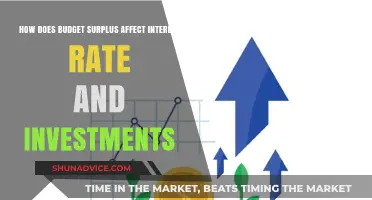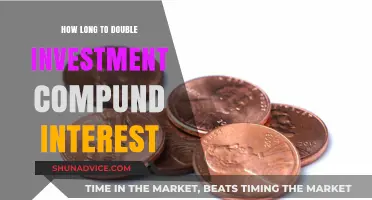
A decrease in interest rates can have a significant impact on investment decisions, as it often serves as a powerful economic stimulus. When interest rates drop, borrowing becomes cheaper, which can encourage businesses and individuals to invest more. This is because lower borrowing costs mean that the cost of capital decreases, making it more attractive to invest in new projects, expand operations, or purchase assets. As a result, a reduction in interest rates can lead to increased investment activity, potentially boosting economic growth and productivity. However, the relationship between interest rates and investment is complex and can be influenced by various factors, including market conditions, investor sentiment, and government policies. Understanding these dynamics is crucial for businesses, investors, and policymakers alike.
What You'll Learn
- Monetary Policy: Lower rates encourage investment by reducing borrowing costs
- Consumer Spending: Reduced rates can stimulate spending, indirectly boosting investment
- Business Confidence: Lower rates signal economic stability, increasing business investment
- Asset Prices: Interest rate cuts can drive up asset prices, attracting investors
- Credit Availability: Easier credit access due to lower rates may increase investment

Monetary Policy: Lower rates encourage investment by reducing borrowing costs
A decrease in interest rates can indeed have a significant impact on investment, and this is a key aspect of monetary policy. When central banks lower interest rates, they are essentially making borrowing cheaper for individuals and businesses. This reduction in borrowing costs can stimulate investment in several ways. Firstly, lower interest rates encourage businesses to take out loans for expansion, research, and development. With reduced financial burden, companies are more likely to invest in their operations, leading to increased production, innovation, and job creation. This is particularly beneficial for sectors like manufacturing, technology, and infrastructure, where large-scale investments are common.
For individuals, lower interest rates can make it more attractive to invest in assets like property or stocks. With easier access to credit, people might be more inclined to purchase a home, which can boost the housing market and related industries. Additionally, lower rates can encourage investors to seek higher returns by taking on more risk, potentially driving up stock market activity. This increased investment activity not only benefits the businesses and individuals directly involved but also has a ripple effect on the economy as a whole.
The mechanism behind this encouragement is straightforward. When interest rates fall, the cost of servicing debt decreases, leaving more disposable income for businesses and consumers. This extra income can then be directed towards investment, either by companies reinvesting their profits or individuals allocating more of their savings towards productive assets. As a result, the economy experiences a surge in capital expenditure, which is a critical driver of long-term growth and development.
However, it's important to note that the effectiveness of lower interest rates in stimulating investment depends on various factors, including the overall economic climate, market conditions, and the specific goals of the monetary policy. In some cases, businesses might be more focused on cost-cutting or debt reduction rather than investment, especially if they are uncertain about the future economic outlook. Nonetheless, the general principle remains that reducing borrowing costs can provide a powerful incentive for investment, making it a valuable tool in the monetary policy toolkit.
In summary, monetary policy that involves lowering interest rates can be a powerful catalyst for investment. By reducing the cost of borrowing, central banks encourage businesses and individuals to allocate more resources towards productive activities, fostering economic growth and development. This strategy is particularly useful during economic downturns or periods of low investment, where stimulating demand and confidence can have a significant impact on the overall health of the economy.
High Interest Rates: A Double-Edged Sword for Investment
You may want to see also

Consumer Spending: Reduced rates can stimulate spending, indirectly boosting investment
A decrease in interest rates can have a significant impact on consumer behavior, particularly in the realm of spending and investment. When interest rates fall, borrowing becomes cheaper, and this can directly influence consumer spending patterns. Here's how it works:
Lower interest rates make loans and credit card balances more affordable for individuals. This encourages people to take out loans for various purposes, such as purchasing homes, cars, or other durable goods. As a result, consumer spending on these big-ticket items tends to increase. For instance, a reduced mortgage rate might entice homeowners to refinance, potentially leading to higher spending on home improvements or other purchases. Similarly, lower car loan rates could motivate buyers to purchase vehicles, stimulating the automotive industry and related sectors.
Additionally, the effect of reduced interest rates on consumer spending is not limited to durable goods. It can also influence day-to-day spending. With easier access to credit, consumers might be more inclined to make impulse purchases or spend on non-essential items. This increased spending can create a ripple effect, as businesses receive more revenue, potentially leading to higher investment in their operations and expansion.
The relationship between interest rates and consumer spending is a crucial aspect of the investment cycle. When consumers spend more, it creates a positive feedback loop. Increased spending generates higher demand for goods and services, which can lead to businesses investing in more production capacity, hiring additional staff, and expanding their operations. This, in turn, stimulates overall economic growth and can attract further investment from various sources.
In summary, a decrease in interest rates can indirectly boost investment by encouraging consumer spending. Lower borrowing costs make it more attractive for individuals to spend on both essential and non-essential items, which, in turn, drives business activity and investment. This mechanism highlights the importance of monetary policy in influencing economic behavior and the potential for interest rate adjustments to have a profound impact on the investment landscape.
Understanding Investment Interest: What It Is and How It Works
You may want to see also

Business Confidence: Lower rates signal economic stability, increasing business investment
Lower interest rates can significantly impact business confidence and investment, creating a positive feedback loop that stimulates economic growth. When central banks reduce interest rates, it sends a powerful signal to businesses and investors alike, indicating a more stable and supportive economic environment. This signal can boost business confidence, encouraging companies to invest in expansion, research and development, and hiring, which in turn can lead to increased production and revenue.
The relationship between interest rates and investment is a critical aspect of economic policy. Businesses often view interest rates as a key indicator of economic health. When rates are low, it suggests that borrowing costs are reduced, making it more affordable for companies to finance their operations and projects. This can lead to a surge in business investment, as companies take advantage of the favorable financial conditions to expand their operations, enter new markets, or invest in innovative ideas. For instance, a tech startup might use lower interest rates to secure loans for research and development, potentially leading to groundbreaking products and services.
Moreover, lower interest rates can encourage businesses to reallocate their capital from savings to investment. With cheaper borrowing costs, companies may be more inclined to invest in long-term projects, infrastructure, or talent acquisition. This increased investment can drive economic growth, create jobs, and contribute to higher productivity levels. As businesses grow and thrive, they become more optimistic about the future, further reinforcing the positive cycle of increased investment and economic stability.
The impact of lower interest rates on business investment is particularly notable in sectors that are sensitive to borrowing costs. Industries such as construction, manufacturing, and retail often rely on external financing for their operations. When interest rates decrease, these businesses can access cheaper credit, making it more feasible to undertake large-scale projects, upgrade equipment, or expand their physical presence. This, in turn, can lead to increased production capacity, improved efficiency, and enhanced competitiveness in the market.
In summary, a decrease in interest rates can have a profound effect on business confidence and investment. It signals economic stability, reduces the cost of borrowing, and encourages businesses to take on more projects and expand their operations. This positive environment can lead to a virtuous cycle where increased investment drives economic growth, creating a more robust and resilient business landscape. As such, policymakers should consider the potential benefits of managing interest rates to foster a thriving business environment and promote long-term economic prosperity.
Interest Rates and Investment: Unraveling the Inverse Relationship
You may want to see also

Asset Prices: Interest rate cuts can drive up asset prices, attracting investors
A decrease in interest rates can have a significant impact on asset prices, often leading to an increase in their value. When central banks or financial authorities reduce interest rates, it typically signals a more accommodative monetary policy, which can stimulate economic growth and encourage investment. This reduction in borrowing costs makes it cheaper for individuals and businesses to take out loans, leading to increased borrowing and, consequently, higher demand for various assets.
One of the primary effects of lower interest rates is the appreciation of asset prices. For instance, in the stock market, companies' share prices can rise as investors anticipate higher returns on their investments. This is especially true for growth-oriented stocks, which are often more sensitive to changes in interest rates. Lower rates create an environment where investors are more willing to take on risk, driving up the prices of these assets. Similarly, in the real estate market, reduced interest rates can lead to a surge in property values as buyers can afford larger mortgages, increasing the demand for housing.
The relationship between interest rates and asset prices is particularly evident in the bond market. When interest rates fall, bond prices tend to rise. This is because existing bondholders can sell their bonds at a higher price, and new investors are attracted to the higher yields offered by these bonds. As a result, the demand for bonds increases, driving up their prices. This effect is crucial for investors seeking safe-haven assets during periods of economic uncertainty.
Moreover, the impact of interest rate cuts on asset prices can create a positive feedback loop. As asset prices rise, investors may feel more confident in their investments, leading to further demand and potentially driving prices even higher. This dynamic can attract more investors, who might fear missing out on potential gains, further fueling the rise in asset prices. However, it is essential to note that this effect can be short-lived, and asset prices may eventually adjust as interest rates stabilize or rise again.
In summary, a decrease in interest rates can have a powerful influence on asset prices, making them more attractive to investors. This phenomenon is a critical aspect of monetary policy and can significantly impact various investment decisions. Understanding this relationship is essential for investors and financial analysts to navigate the market effectively, especially during periods of changing interest rates.
Understanding Compound Interest: How Investments Grow Over Time
You may want to see also

Credit Availability: Easier credit access due to lower rates may increase investment
A decrease in interest rates can significantly impact the availability of credit and, consequently, investment. When interest rates fall, borrowing becomes more attractive to both individuals and businesses. This is because the cost of borrowing decreases, making it financially viable to take out loans for various purposes, such as expanding operations, purchasing assets, or starting new ventures. As a result, banks and financial institutions are more inclined to lend, leading to an increase in the overall credit supply.
Easier credit access is a direct outcome of lower interest rates. With reduced borrowing costs, potential borrowers are more likely to approach lenders for financing. This increased demand for credit encourages banks to relax their lending criteria, making it simpler for borrowers to secure loans. As a result, businesses can access the capital they need to invest in their operations, hire more employees, or develop new products, all of which contribute to economic growth.
The relationship between lower interest rates and increased investment is particularly evident in the housing market. When interest rates drop, mortgage rates tend to follow suit, making home loans more affordable. This encourages more people to enter the housing market, either by purchasing a new home or refinancing their existing mortgages. Increased home sales and refinancing activities stimulate the economy, as they generate demand for various goods and services, creating a ripple effect of investment and economic activity.
Additionally, lower interest rates can encourage businesses to invest in long-term projects that may have been deemed unattractive at higher rates. For instance, a company planning to launch a new product line might find it more feasible to invest in research and development when the cost of borrowing is reduced. This increased business investment can lead to technological advancements, innovation, and the creation of new jobs, further boosting the economy.
In summary, a decrease in interest rates has a profound effect on credit availability and investment. It encourages easier access to credit, stimulates borrowing, and provides businesses and individuals with the financial flexibility to make significant investments. As a result, the economy benefits from increased economic activity, job creation, and overall growth, demonstrating the powerful role that interest rates play in shaping investment decisions.
Low Interest Rates: Boosting Investment or Hindering Growth?
You may want to see also
Frequently asked questions
A reduction in interest rates often encourages investment as borrowing becomes cheaper. Lower rates mean that the cost of borrowing money for business expansion, equipment purchase, or property development decreases, making it an attractive option for investors. This can stimulate economic activity and lead to increased investment in various sectors.
Yes, there is a significant correlation. When interest rates fall, the opportunity cost of holding cash decreases, and investors are more inclined to invest in assets or projects. This is because lower rates make borrowing more appealing, allowing businesses and individuals to finance their ventures with reduced financial burden. As a result, a decrease in interest rates can directly boost investment levels.
Absolutely. While the initial impact of lower interest rates may be stimulating, the long-term effects can be substantial. Over time, sustained low-interest rates can encourage businesses to invest in research and development, infrastructure, and skilled labor. This can drive innovation, productivity, and overall economic growth, resulting in a more robust investment environment.







